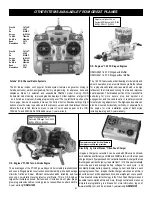
For reassurance and to keep an eye on other traffic, it is a
good idea to have an assistant on the flight line with you. Tell
him to remind you to throttle back a little once the plane gets
to a comfortable altitude. While full throttle is usually
desirable for takeoff, full throttle is usually not required for
straight-and-level flight.
Take it easy with the Eagle for the first few flights, gradually
getting acquainted with it as you gain confidence. Adjust the
trims to maintain straight and level flight at cruising speed.
After flying around for a while and while still at a safe altitude
with plenty of fuel, practice slow flight and execute practice
landing approaches by reducing the throttle to see how the
model handles at slower speeds. Add power to see how she
climbs as well. Continue to fly around executing various
maneuvers and making mental notes (or having your
assistant write them down) of what trim or C.G. changes
may be required to fine tune the model so it flies the way you
like. Mind your fuel level, but use this first flight to become
familiar with the Eagle before landing.
One of the keys to landing a giant-scale model is to maintain
sufficient airspeed throughout the landing approach. An
unusually high airspeed is not necessary, but those unfamiliar
with landing giant-scale models are sometimes deceived by
the model’s larger size. Larger models often appear to be
closer than they actually are. Additionally, most giant-scale
models slow down rapidly, thus causing the uninitiated to land
short. To avoid this initial illusion, make your landing pattern
closer than you normally might for a .40-size sport model.
Also, don’t pull the throttle all the way back and leave it there
the way you normally would. Instead, momentarily pull the
throttle all the way back, but then advance it a “click” or two to
keep the engine RPM up and maintain airspeed. Once over
the runway you can cut the throttle the rest of the way and the
model will slow for the landing flare.
To initiate a landing approach, lower the throttle while on the
downwind leg. Allow the nose of the model to pitch downward,
simultaneously losing altitude while maintaining airspeed.
Continue to lose altitude and keep the nose down as you turn
onto the crosswind leg. Make your final turn toward the
runway (into the wind) monitoring airspeed and adding throttle
if necessary. Level the attitude when the model reaches the
runway threshold, modulating the throttle as necessary to
maintain your glide path and airspeed. If you are going to
overshoot, smoothly advance the throttle (always ready on the
right rudder to counteract torque) and climb out to make
another attempt. When ready to make the landing flare and
the model is a foot or so off the deck, smoothly increase up
elevator until it gently touches down. Once the model is on the
runway and has lost flying speed, hold up elevator to place the
tail on the ground, regaining tail wheel control.
One final note about flying your Christen Eagle. Have a goal
or flight plan in mind for every flight. The goal could be
learning a new maneuver, perfecting known maneuvers, or
learning how the model behaves in certain conditions (such
as on high or low rates). This is not necessarily to improve
your skills (
though it is never a bad idea!), but more
importantly so you do not surprise yourself by impulsively
attempting a maneuver without any planning. Every
maneuver should be deliberate. For example, if you’re going
to do a loop, plan it out—check your altitude, mind the wind
direction (anticipating rudder corrections that will be
required to maintain heading), remember to throttle back on
the down side and make certain you are on the desired rates
(high/low rates). A flight plan greatly reduces the chances of
crashing just because of poor planning and impulsive
moves. Remember to think!
Have a ball!
But always stay in control and fly in a safe manner.
GOOD LUCK AND GREAT FLYING!
Landing
Flight
48





































